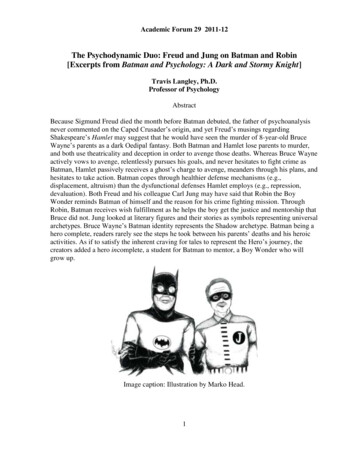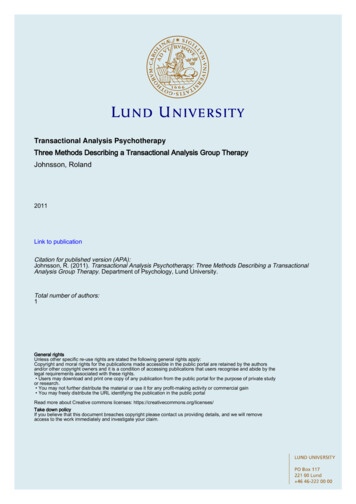
Transcription
Academic Forum 29 2011-12The Psychodynamic Duo: Freud and Jung on Batman and Robin[Excerpts from Batman and Psychology: A Dark and Stormy Knight]Travis Langley, Ph.D.Professor of PsychologyAbstractBecause Sigmund Freud died the month before Batman debuted, the father of psychoanalysisnever commented on the Caped Crusader’s origin, and yet Freud’s musings regardingShakespeare’s Hamlet may suggest that he would have seen the murder of 8-year-old BruceWayne’s parents as a dark Oedipal fantasy. Both Batman and Hamlet lose parents to murder,and both use theatricality and deception in order to avenge those deaths. Whereas Bruce Wayneactively vows to avenge, relentlessly pursues his goals, and never hesitates to fight crime asBatman, Hamlet passively receives a ghost’s charge to avenge, meanders through his plans, andhesitates to take action. Batman copes through healthier defense mechanisms (e.g.,displacement, altruism) than the dysfunctional defenses Hamlet employs (e.g., repression,devaluation). Both Freud and his colleague Carl Jung may have said that Robin the BoyWonder reminds Batman of himself and the reason for his crime fighting mission. ThroughRobin, Batman receives wish fulfillment as he helps the boy get the justice and mentorship thatBruce did not. Jung looked at literary figures and their stories as symbols representing universalarchetypes. Bruce Wayne’s Batman identity represents the Shadow archetype. Batman being ahero complete, readers rarely see the steps he took between his parents’ deaths and his heroicactivities. As if to satisfy the inherent craving for tales to represent the Hero’s journey, thecreators added a hero incomplete, a student for Batman to mentor, a Boy Wonder who willgrow up.Image caption: Illustration by Marko Head.1
Academic Forum 29 2011-12Sigmund Freud (1856-1939) died the year Batman debuted, in the month before thecharacter’s origin saw print. While the founder of psychoanalysis never commented on ourhero’s background, he wrote a great deal on related topics from which we might infer what hewould have had to say. The role of early childhood experience and the power of trauma to routethe course of personality, the very things that created Batman, fascinated Freud. To him, earlyexperiences create conflicts and unconscious turmoil we wrestle with throughout our lives.Conscious of the circumstances that drive him, Batman in many ways is ahead of most people.Freud, perhaps the most famous figure in the history of psychiatry and psychology,developed the first and best known formal theory of personality. Many later personalitytheories arose either to elaborate upon or to oppose Freud’s views. He stirred controversy withhis proclamation (soon withdrawn) of cocaine as a wonder drug for treating mood disorders(Freud & Byck, 1974; Thornton, 1983) and his psychodynamic perspective which assertedthat our own minds play tricks on us, that unconscious processes that elude awareness guideour conscious lives, and that the human sex drive spurs personality development from infancyinto adulthood (Freud, 1940). A number of followers who initially intended only to expandupon his theory – like Carl Jung, Karen Horney, and Erik Erikson – each came to break awayas their ideas came to contradict his, often beginning with disagreements over sexuality’s role(Erikson, 1959; Freud & Jung, 1974; Horney, 1939). Rather than minimize the importance ofthe unconscious mind like some neo-Freudians, Jung emphasized it more heavily than Freud,adding a deeper dimension popular in the study of heroes: the collective unconscious sharedthroughout our species (Jung, Henderson, von Franz, Jaffé, & Jacobi, 1964). Despitecontroversies, both Freud and Jung remain influential to this day and provide frameworks foranalyzing fictional characters and their stories.Most psychologists are not Freudians. Freud’s ideas frequently lacked falsifiability –disprovability, meaning that no conceivable empirical outcome could have contradicted him.He said stairways in dreams represent sexual intercourse (Freud, 1899/1965, p. 390). Youcannot prove that wrong any more than you can prove no organ grinder ever played cribbage inany of your ancestors’ kitchens. Einstein asserted that faster than light travel is impossible.Because a single supraluminal jaunt would refute his assertion, the idea itself – whether right orwrong – was scientific. One important reason why Jung broke away from Freud was that Jung,although a religious man, felt dogma in any form – in Freud’s case, his insistence that sexualfoundations underlay all psychological development – had no place in an empirical discipline.Nevertheless, we can easily speculate on what Freud might have said about Batman. Hesaid a great deal about how traumatic experiences will affect boys at around the age Bruce waswhen his parents died.Freud’s Psychodynamic FoundationsThe cornerstone of Freud’s psychoanalysis was his view that the unconscious mindcontinually influences us in ways the conscious mind does not realize. In his view, earlyexperiences shape personality and create inner conflicts we wrestle with throughout our lives.This unconscious turmoil stirs up difficulties in conscious life.2
Academic Forum 29 2011-12He felt that we have two main instincts driving our behavior: a life instinct that hecalled Eros for the Greek god of erotic love and a death instinct he called Thanatos for theGreek god of death. He had much more to say about the life instinct. We spend all our timebeing alive and only a certain portion of it focusing on death and destruction. The life instinctor libido (all mental energy) would drive sex, activity, construction, creativity, hunger, and allthe activities involved in keeping us and our species going – the kind of things for whichplayboy Bruce Wayne pretends to live. So Batman’s ongoing efforts to save lives, as a lifeoriented activity, would be his form of sexual expression on “Planet Freud”. Seeing this as onewide-ranging instinct, Freud considered it all sexual in nature. The death instinct, on the otherhand, would prompt aggression, destruction, and preoccupation with morbid topics. Dwellingon this could create antisocial or suicidal inclinations. The death instinct can serve life.Sometimes you need to fight off the wolves. Sometimes you must demolish one thing in orderto build another. Batman’s aggression and his terrifying image help him shield others fromfates like his family’s.A Freudian might take the view that the three-part Batman character (Bruce’s playboyfaçade, Batman the superhuman symbol, and the real man behind both) represents the threemajor structures of personality – not that they directly are the three structures, simply that theycould symbolize them. At the beginning of life, personality consists of nothing but id, theinnate animal self driven by those inborn instincts. It operates on the pleasure principle,seeking immediate gratification, immediate fulfillment of needs and desires. Playboy Brucewould embody the id. Around age three, we develop the ego, the executive structure whichincludes the conscious mind and learns to operate on the reality principle. Whereas an infanthas no concept of patience, no initial tolerance for waiting, a child will learn that we can oftenachieve greater satisfaction by waiting. Because Batman is the main self, the identity that allBruce’s other efforts support, he might represent the ego. When his surrogate mother, Dr.Leslie Thompkins, gestures to the bat insignia on his chest and says, “This is not the real you,Bruce,” he tells her in Detective Comics #574 (1987), “It is the only me there is, Leslie.”Batcave Bruce, the hero unmasked and partially costumed down in the Batcave, the one placehe might speak freely or reveal his injuries, sits at his giant computer using analysis andrational thought to achieve things his fists cannot – guided by the basic morality exemplified bysurrogate father Alfred, who represents his conscience. This part of the superhero couldrepresent his superego. Both id and superego influence the ego, which must balance theirrespective wants to forge its own path, something strong-willed Batman with his great strengthof ego should handle well.Why is Batman so strong-willed? Where did he get such discipline and self-control?Freud would credit Bruce’s toilet training. Freud believed we experience a series ofpsychosexual stages of development that sculpt our psyches and have lasting impactthroughout our lives, each stage focusing on a different erogenous zone (sexually excitablearea) with a distinct manner by which we go about satisfying those life and death instincts. Inany stage, a person might develop a fixation, failing to outgrow that stage emotionally whether3
Academic Forum 29 2011-12because of trauma, underindulgence (creating a lingering ache to satisfy unfulfilled needs), oroverindulgence (making the child too comfortable to want to mature).Whether Bruce’s parents died when he was 6 as Frank Miller writes (Batman #404-407,1987) or 8 according to Dennis O’Neil (Secret Origins, 1989) and others, the boy would haverecently passed through the phallic stage’s most intense conflict, which Freud considered earlylife’s most important issue. He believed phallic stage fixation could produce narcissism(obsessive self-love), flamboyance (running around wearing a cape surely qualifies), orhomosexuality (despite a lack of subsequent evidence to show that he was right about that).While he might have concurred with psychiatrist Wertham’s contention (1954/2004, p. 190)that Bruce Wayne and Dick Grayson were living a homosexual “wish dream,” Freud did notview homosexuality as deviant.Freud’s (1909) key ideas about the phallic stage originated in his treatment of a boy hecalled Little Hans in his writings. Hans suffered such severe equinophobia, fear of horses, thathe would barely go outside, horses being as common circa 1900 as cars are today. Freudconcluded that the reason Hans was so afraid of being bitten by a horse was that he was in lovewith his mother and afraid his father was going to castrate him. Freud considered him a littleOedipus, after the figure from Greek tragedy who kills his own father and marries his mother –hence, the Oedipus complex. Regardless of whether Freud was right about Hans’s fear of ahorse biting him symbolizing the deeper fear that his father might castrate him, Hans did havefantasies about marrying mommy, animosity toward his father, and preoccupation with the fearthat they might cut off part of his anatomy – although in his case, he has reason for thecastration anxiety. He had been told that if he did not stop fidgeting with his “widdler,” itwould get cut off – and his sister did not have one. They would have done it before! Manysources erroneously credit Freud for proposing an equivalent Electra complex for girls when,in fact, Freud refuted Carl Jung’s (1913) Electra proposal. Freud generalized Hans’s phallicpreoccupation to all children, positing that castration anxiety worried every little boy and penisenvy irked every little girl. Hans eventually began acting more like his father, incorporating theman’s manner and moral values, which Freud interpreted as an act of identification, becomingmore like the father in order to get along with him. Each little boy supposedly develops hissuperego, the conscience, so dad will not threaten his penis and each little girl develops hers soshe can psychologically grow one.In Freud’s view, therefore, Bruce had undergone that entire conflict – including a wishto have his father out of the way and occasional resentment toward his mother for being withhis father – but could have recently resolved this by identifying with his father and crystallizinghis superego, his moral core. Now entering latency, that period of time when Freud of allpeople did not see much of anything sexual going on, the boy would no longer have been thesex fiend he was back at age 5. (Remember, we are still exploring “Planet Freud” for themoment – most of us do not consider preschoolers’ underlying motivation primarily sexual innature.) Instead his mind was opening itself up to picking up new skills and learning about thegreat big world, right when a mugger’s bullets shattered that world.4
Academic Forum 29 2011-12Image caption: Young Bruce immediately understands the horror of his parents’ murder andmakes meaning of it. DC Comics, used with permission.Batman vs. Hamlet Act I: Murder Most FoulTo help us speculate on what Freud might have said about Batman, we can glean cluesby looking at what he had to say about another fictional character whose parents get murdered,a young man with different Oedipal issues, William Shakespeare’s Prince Hamlet. Differencesbetween Batman and Hamlet still prove useful in this task. In both stories, the hero’s father getsmurdered first – Bruce’s father Dr. Thomas Wayne by a mugger who wants to steal mother’spearls, Hamlet’s father King Hamlet by the uncle who wants to steal the mother and the crown.Bruce witnesses the murder; Hamlet later learns his father’s death had been a murder. MaryWayne gets robbed and murdered; Hamlet’s mother Gertrude gets married to her husband’skiller and is later inadvertently murdered by him as well. Bruce has few doubts; Hamlet hasthem aplenty. Bruce knows that murder has occurred but not the killer’s identity; Hamletknows the killer’s identity but needs to confirm that it was murder. Bruce Wayne is an active,decisive individual who knows what he wants, forms a plan, and pursues it; Hamlet is passiveand uncertain, although to some extent he has good reason to proceed with caution. In case thespirit that visited Hamlet was not actually his father’s ghost but was instead some demon tryingto trick him into murdering a man, he first wants to prove murder happened at all. He andBruce both want to be better than the killers they pursue. They both resist killing.For centuries, scholars have contemplated why Hamlet goes through the elaborate ruseof acting insane while hesitating to kill his uncle even after establishing the man’s guilt. Freudsaid Hamlet perceives his murderous uncle as “the man who shows him the repressed wishes ofhis own childhood realized” (1899/1965, p. 299). The killer reminds the son, at leastunconsciously, of the part of himself that wanted to eliminate his father and have his mother tohimself. Freud would likely have considered it significant that Bruce Wayne’s father dies first.By taking the mother’s necklace – established by later stories to have been a gift from Thomas,5
Academic Forum 29 2011-12a symbol of their affection – and shooting her too, the mugger would remind Bruce of anyoccasional resentment he had felt toward her for choosing father over son.Both newly fatherless sons take oaths. Whereas Bruce actively chooses to avenge hisparents, Hamlet receives a spectral mandate to avenge. Note that in their respective oaths,neither son vows to slay his father’s slayer, neither promises to punish the man who has givenhis own Oedipal fantasy its reality. Bruce swears to take action, “to avenge their deaths byspending the rest of my life warring on all criminals,” not to devote himself to hunting downthe man who killed them. Hamlet vows inaction, in that he gets his friends to join him inswearing only that they will not tell anybody they saw a ghost.Batman vs. Hamlet Act II: The Defense MechanismsOne area where many psychologists view Freud favorably is his proposal that we use avariety of automatic tactics to protect ourselves from anxiety, especially against threats to selfimage, often without realizing we are using these defense mechanisms (or ego defensemechanisms). We all lie to ourselves sometimes. We avoid topics that unnerve us, devaluethings we cannot have (“sour grapes”), and shield ourselves from stress in many others ways.Sigmund’s daughter Anna Freud (1936) deserves credit for giving names to numerousprocesses which her father had described without labeling and for identifying additionaldefense mechanisms he never addressed.Freud saw Hamlet, Prince of Denmark as a story of repression, whereby theunconscious mind hides disturbing wishes, thoughts, and experiences from consciousawareness. Unlike Oedipus, who killed his own father and married his mother, Hamlet saw aman other than himself live out his childhood Oedipal fantasy, a fantasy Freud (1899, p. 299)said Hamlet has repressed: “Thus the loathing which should drive him on to revenge is replacedin him by self-reproaches, by scruples no better than the sinner whom he is to punish.”Batman’s story, on the other hand, is one of displacement, acting on one’s feelings butfocusing them on a different target because the original target is inappropriate or unavailable –for example, rather than pursue your roommate’s boyfriend whom you find desirable, youconvince yourself you are having those feelings about his buddy. Because Batman never bringshis parents’ killer to justice, every hoodlum he hits serves as a substitute for the man whoslayed them.Using defense mechanisms can be healthy, even necessary, to keep harsh reality fromoverwhelming us. The American Psychiatric Association’s (2000) Diagnostic and StatisticalManual of Mental Disorders (DSM) distinguishes the defenses that help us best cope withreality. These “mature” defenses, as Vaillant (1977) called them, maximize our ability to feelgood about life while staying aware of memories, feelings, and thoughts. Hamlet still has hiswit, his sense of humor, with a particular fondness for wordplay, but for the most part heutilizes fewer of these healthier defenses than Batman does. Bruce Wayne lives a life ofaltruism, self-assertion, and, even as distant as Batman might seem, greater affiliation withhis sidekicks, superhero teams, and the rest of Gotham’s Bat-Family (Batgirl, Batwoman,6
Academic Forum 29 2011-12Oracle, etc.) than anything Hamlet shows. Although each has a confidante (Alfred for Batman,Horatio for Hamlet), Hamlet more consistently than Batman cuts himself off from all others.Thought suppression helps Batman keep distractions from weakening his focus, butsuppressed thoughts remain easily accessible to the conscious mind, unlike all the thingsHamlet keeps repressed. Batman exemplifies one definition of the defense introjection in thathe identifies so strongly with a particular image or symbol that he has incorporated it into hisidentity. Spending at least 15 years training himself in anticipation of his crime fightingmission differs markedly from Hamlet’s often aimless hesitation. During that anticipatoryperiod, Bruce Wayne passes up opportunities to develop friends and girlfriends, discardingcollege acquaintances even though he wanted them, “and the ache he felt seemed to fill hisentire being. He learned to ignore the ache, and the pain of loss and isolation. These were theconditions of his life, and he accepted them” (Secret Origins, 1989, p. 7). Social and sexualdrives get rerouted into training for his mission – this is an example of sublimation, feelingone need or impulse but channeling that energy into some other activity.Both Bruce and Hamlet use mental inhibitions, the mildly neurotic defensemechanisms that compromise information, keeping fears and other potential threats hiddenfrom our awareness. Like a police detective who must separate whatever feelings he has abouta case from the thoughts and actions needed to do his job, Batman has feelings but must isolatethose affective reactions from the brutal reality he faces. He tries not to let shock slow himdown or anger blind his perception. He and Hamlet both channel emotional energy intoanalysis, but Hamlet overanalyzes to the point of intellectualization, using reason to avoidconfrontation with an unconscious conflict. Both use reaction formation, a type of sublimationin which the person has one impulse but does the opposite instead, as when they each driveaway women they find appealing – in Hamlet’s case, cruelly so.Hamlet uses more dysfunctional defenses than Batman – apathetic withdrawal afterhis father dies, idealization of that father, devaluation of the mother, rationalization (makingexcuses) for his hesitation to avenge his father even after satisfying himself that his unclecommitted murder, and passive aggression throughout. Hamlet is suicidal. Batman is not. Hesurvived that night in the alley and remains a survivor night after night.Batman vs. Hamlet Act III: Theatricality and DeceptionBoth put on performances, one to expose a villain and the other to scare all villains.Hamlet plays the mad prince; Wayne plays both the bored playboy and the dark symbol thatmust become “more than a man.” Deception permeates their relationships, especially those thatshould be most intimate (with notable exceptions being their respective confidantes), and yetthey both enlist help in their deceptive practices. Playing “mad” helps Hamlet hide hissuspicions toward his uncle but does nothing to help him expose or destroy the man. When atroupe of traveling actors happens to come along, Hamlet requests that they perform a specificplay so that he might gauge his uncle’s reaction when they depict a murder similar to hisfather’s. Even those whom Batman deceives as Bruce Wayne, including CommissionerGordon, help him with performances of his own.7
Academic Forum 29 2011-12When Hamlet finally uses violence, striking an eavesdropper behind an arras whilehoping it is the uncle he still cannot bring himself to confront face to face, he begins toillustrate the advantages of Batman’s healthier, more consistently active coping strategies.Hamlet kills the wrong person. Soon he shows signs of psychosis (mental illness or at least atemporary state in which the person is grossly out of touch with reality) when his father’s ghostreappears but, unlike the Act I appearance when three others saw the ghost with him, hismother sees no ghost. Either she, having betrayed her late husband by remarrying so soon, isnot permitted to see the ghost or Hamlet is having a hallucination, a psychotic symptominvolving a false perception disconnected from real world stimuli. Batman does not havedelusions, beliefs grossly out of touch with reality, nor does he hallucinate – not unlessexposed to some supervillain’s hallucinogenic toxin, spell, or telepathic whammy – but thoseare career hazards every superhero faces from time to time.Image caption: Ducard (Liam Neeson) teaches Bruce (Christian Bale) the importance of“theatricality and deception” while trying to turn him against his late father’s memory inBatman Begins (2005). Warner Bros.Batman vs. Hamlet: CurtainsBruce Wayne carries out a long-term plan which includes avoidance of killing; whatlittle plan Hamlet forms falls apart after he finally, blindly kills. Hamlet’s fate demonstrateswhy Batman draws the line he will not cross: Once the killing starts, the wrong people cansuffer – a mistake no one can undo. Of the seven characters killed in Hamlet’s latter half, fivewere not the originally intended or hoped-for targets. Only at the play’s end, when Hamletstabs his uncle and then succumbs to his own envenomed wound, do the intended victims die.Batman gets no Act V. His story in the comic books does not close. Numerous comicshave presented variations of the character’s possible future but never his canonical end. In fact,even those unofficial future tales tend not to end with his death (e.g., The Dark Knight Returns,1986, Kingdom Come, 1996, Batman #300). Parallel universe stories that do depict deaths of8
Academic Forum 29 2011-12other worlds’ Batmen often confirm that DC’s main Batman has followed the wiser path (e.g.,Countdown #14, 2008).The Inner Child: RobinWhereas Sigmund Freud emphasized the importance of life’s earliest years and wouldhave dwelled on the Waynes’ deaths, Carl Jung (1971) considered individuation (individualpersonality growth, integrating diverse aspects of oneself to form a whole and healthy identity)a lifelong process and would have cast his gaze wider across the entire course of BruceWayne’s life. Despite acknowledging that early experience influences us, Jung feltpsychological disturbances are more rooted in the present than in the past and that therapistsshould spend more time helping clients with the direction they’re taking into the future.Both would have said that Robin the Boy Wonder reminds Batman of himself and thereason for his mission. Robin is a living symbol of the boy Bruce had been when he lost hisparents and the boy he might have become under other circumstances. After all, Dick Graysonlooks like young Bruce, his parents resemble Bruce’s, and both are about the same age whenthey witness their respective parents’ murders. Subsequent Boys Wonder Jason, Tim, andDamian all look like young Bruce, and Batman swiftly fires the only official Girl Wonder,blond Stephanie Brown (Robin #128, 2004). Through Robin, Batman receives vicarious wishfulfillment as he helps the boy get what young Bruce did not: guidance, crime fighting as afather and son activity, justice, and thus closure. In their first case together, Batman and Robinsend the Graysons’ killer to jail.Freud and Jung would have disagreed a bit on why Batman welcomes that symbol ofhis own childhood. Looking at how past crisis lingers with us via processes like fixation andrepression, Freud might say that little boy Bruce, having never outgrown that night, alwaysremained an important part of Batman’s fixated psyche. Jung, on the other hand, felt that pastconflicts tend to influence us most when present difficulties bring them up again. Regression,another defense mechanism, involves seeking comfort by reverting to behavior from an earlierpoint in life, like the toilet trained child who resumes bedwetting during her parents’ divorce orthe ex-smoker who lights up while going bankrupt. Jung agreed boys experience the Oedipusconflict, but he felt that it was unlikely to play an important role later unless the man reacted tocurrent parental issues (e.g., Hamlet’s ire toward his mother for remarrying so soon) byregressing or emotionally returning to a conflict long since left behind.For Batman, Robin is not an unconscious symbol but rather a conscious reminder. InRobin’s debut (Detective Comics #38, 1940), “Batman thinks back to the time when hisparents, too, were innocent victims of a criminal,” and he tells Dick, “My parents too werekilled by a criminal. That’s why I’ve devoted my life to exterminate them.” By helping the boyget justice, Batman returns to his parents’ murder and gets to experience what a better postmurder outcome could have felt like.9
Academic Forum 29 2011-12Jung would also examine Robin’s role as a symbol of the Child archetype and thatchild’s place in the hero’s journey.Jung’s Archetypes: Shadow of the Bat“Patients suffering delusional episodes often focus their paranoia on an externaltormentor, usually one conforming to Jungian archetypes,” or so says psychologist JonathanCrane, a fictional character also known as the Scarecrow in the 2005 motion picture BatmanBegins. Carl Jung (1875-1961) mentioned Superman in his work, seeing Superman as the mainpersonality and Clark Kent as Superman’s Shadow, but we can only speculate on how he wouldhave assessed Batman. Of particular importance is Jung’s theory that the collectiveunconscious, an inborn stratum of the psyche inherited by all humankind, prepares us toperceive and create themes that fit abstract, instinctive patterns called archetypes whichorganize the things we see and do (Jung, 1919). Certain themes and character types emerge inthe legends and myths of every culture in the history of the world. Jung (1936) said thearchetypal pattern is not a question of inherited ideas, but of inherited possibilities of ideas. TheJoker is no more an inherent feature of every human psyche than is the mischievous Norse godLoki, but each has qualities common to rascally characters that stir trouble, challenge heroes,and push mortals on to greater heights in tales told throughout time. They are symbols of theTrickster archetype. Each fits within its mold, imperfectly sculpted with touches added andbits trimmed away by myriad storytellers over the course of many years.Jungian therapy involved helping the client both face reality and delve into theunconscious. In early treatment, the client encounters the principal features of the personalunconscious (the part of the unconscious gathered over a lifetime, not inherited): the Shadowand the Persona. The Shadow archetype represents your dark side, not necessarily your evilside but the part of you that is hidden, out of the light, the sum of those characteristics you wishto conceal from both the world and yourself. We fear it. In Dr. Jekyll and Mr. Hyde, a potionthat Henry Jekyll hopes might eliminate evil releases a person’s darkest inclinations instead andlets his Shadow take control. Appropriately enough, given that Walter Gibson’s The Shadowhelped inspire the Dark Knight’s creation (Kane & Andrae, 1989, p. 41), Batman is a Shadowcharacter. Bruce Wayne confronts his own darkest nature early in life, chooses to work with it,and uses it to instill fear in others. His bright and dark sides work together to fight evil.Superheroes commonly have Shadow foes, enemies that are twisted counterparts tothemselves: Flash vs. Reverse-Flash; Green Lantern vs. Sinestro the Yellow Lantern; brutalgamma-mutated Hulk vs. super-smart gamma-mutated Leader. These twists take many forms.Superman has both Bizarro, a dim-witted super-strong freak who does harm through hisignorance, and Lex Luthor, a non-superpowered scientist who does intentional evil for selfserving purposes – each a funhouse distortion from a different angle. Because Batman ishimself a Shadow character, his Shadow foes become more freakish, more complicated thanstrong/dumb/amoral or mortal/smart/immoral. Inspired by a movie poster featuring Spencer
[Excerpts from Batman and Psychology: A Dark and Stormy Knight] Travis Langley, Ph.D. Professor of Psychology Abstract Because Sigmund Freud died the month before Batman debuted, the father of psychoanalysis never commented on the Caped Crusader’s origin, and yet Freud’s musings regarding










